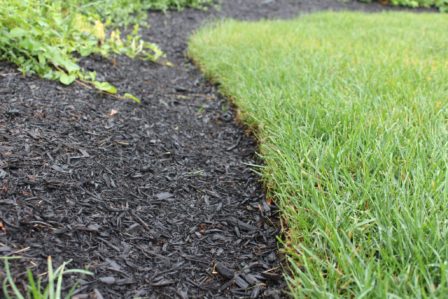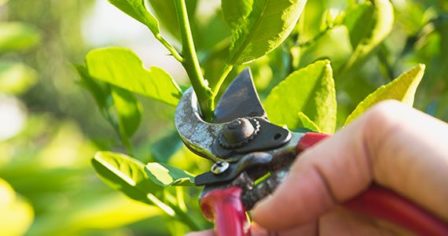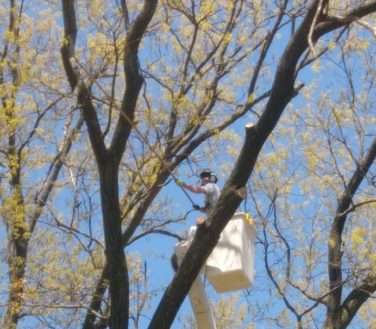Home improvement stores really stink sometimes. They do a great job of marketing their products and what they think you should be doing each Spring. They’re great at making you feel empowered and capable of “DIY” projects. But they’re pushing their agenda, and not necessarily what’s best for you as the homeowner. There are many landscaping considerations to take in.
For example, as a professional lawn care company, we always cringe a little in Spring. This is when the commercials air, telling you that Spring is the time to re-seed your lawn. Here in Central Pennsylvania, Spring is viable, but not the best time to re-seed your lawn. Fall is, by far, the best option.
Here are a few other examples of what you really need to know about your landscaping before Spring.
 There’s a right way (and a wrong way) to mulch your beds.
There’s a right way (and a wrong way) to mulch your beds.
Mulch is one of those things that is frequently overlooked or taken for granted by many homeowners. Can you go buy mulch at the home center and do it yourself? Yes.
But how much should you buy? How deep should it be? How do you properly edge the beds? Why should you edge the beds? There’s still a lot of questions, even with this seemingly simple “DIY” task.
Here’s the scoop: you should never mulch more than 3” maximum for most landscape plants. In reality, you should keep mulch between 1 ½”-2” in most cases. Mulch should also be thinner directly under shrubs in the landscape plant (maybe a ½”) and get progressively deeper as it moves away from the trunk of the plant. You should follow this practice for your entire landscape, trees included.
You should also avoid what is commonly known as “volcano mulching” your trees. Many homeowners (and a few landscape companies, too!) practice this. Volcano mulching is where the mulch is thickest and deepest against the trunk of the tree. Doing this only encourages a host of potential problems for the tree, such as insect damage, possible rodent damage, and girdling roots. Girdling roots happen, in this example, when the mulch is so thick that the tree grows roots above the soil line, which reach across the trunk. The pressure resulting on the trunk itself inhibits the flow of moisture and nutrients up and down the trunk, causing the tree to die. In addition, water may not even reach the root system if the mulch is too thick!
Trimming the shrubs is more than just a DIY job!
There are certain shrubs that should and should not be trimmed in the spring. Many of your perennials that weren’t cut back in the fall (such as Karl Foerester grass, dwarf fountain grass, or liriope) can still be done earlier in the spring.
However, there are several types of shrubs that should NOT be trimmed at this time of year, however. Doing a trim on your azaleas, rhododendrons, lilacs, forsythia, and even some viburnum could be detrimental to the plant. Why? Because they haven’t bloomed yet! You’ll disrupt several important parts of the ecosystem (like pollinators), and you won’t even get the benefit of seeing these plants bloom beautifully! This is by no means an exhaustive list of plants that require trimming at a specific time of year, either.
Other landscaping considerations
There are other elements to consider as well when thinking about shrub trimming. What about security? Keeping clear sight-lines from your home to your property lines is important. How else would you know if an unwelcome (or merely just unexpected) visitor is approaching your home? This is an especially important consideration for many of our elderly and aging clients.
Then there’s cultural considerations, too. Neglecting the shrub trimming can lead to other pest problems on the property. For instance, having certain shrubs too close to the side of the home can foster the introduction of household pests, like ants. Letting the shrubs grow wild too close to the side of the home can also provide habitat and shelter from predators for rodents, like voles and mice.
And what about aesthetics? You want your shrubs to look nice, too, don’t you? We’ve all seen that neighbor that just hacks away at a shrub and it looks awful for a few years, assuming the plant ever recovers from the, um, “energetic” trimming efforts.
All of this is to say that there’s a lot more involved in shrub trimming than just giving the yews a buzz cut. You should seriously consider involving a professional.
There is no substitute for professional tree pruning.
This is another frequent conversation you’ll hear around the office of any professional tree pruning company: “Yes Mrs. So-And-So, I’m sure you can find someone else to do the work for less, but…”
Here are two of those “But’s” you’re going to hear when you call a true tree pruning professional…
 Insurance
Insurance
“But, we’re fully insured.” Please ask if the professional you’re working with is insured. If they are, you’ve got far less concerns about damage to people or property while they are working. If not, you as the homeowner might be liable for injuries or damage. What happens if Joe’s Tree Trimming (no intended slight to readers named “Joe”) drops a limb on your neighbor’s shed? Who’s paying for that? That all depends on if you asked the question about insurance.
Professionalism
“But, we’re Certified Arborists.” Sounds like it might be common sense, but not everyone takes the time to check. One of the many benefits of having a Certified Arborist do your estimation and work is that there’s a consistent level of training that goes along with it. You know there’s an independent organization that has held these people you’re considering hiring to a certain high, professional standard. (This organization is the International Society of Arboriculture, or ISA.)
Another benefit is that you know they generally will not do work that will damage your precious landscape. As a company with many ISA Certified Arborists on staff, we often have to have a difficult conversation with a client about not “topping” a tree to reduce its height. This practice often reduces the longevity of trees and puts an undue amount of stress on them. A Certified Arborist is going to know where to make cuts to promote tree health, not cause harm.
Pest and Disease Issues
Also, having a Certified Arborist allows you to have a professional eye to diagnose and treat pest and disease issues with a tree that you might not otherwise know about. How upset would you be if you spent hundreds of dollars on a pruning job, only to find out later that the tree had a curable disease or preventable pest problem?
For example, you go with Joe’s Tree Trimming (again, sorry to all readers named “Joe”), and they cut back some dying limbs on your ash tree. The next year, you see even greater decline, and call them out again for another few hundred bucks. Eventually, you have to have the tree removed, for yet more money. All of this was because you didn’t call a Certified Arborist, who could have recommended treatment for a fraction of the cost, and actually saved the tree. A treatment for Emerald Ash Borer in this example could have preserved the life of the tree and probably not broken the budget.
Conclusion
There are several considerations for your landscape each Spring. Now that the season is upon us, it’s time to get your “To-Do” list in order. If you’d like to ask us some questions specific to your landscape, please Contact Us.

